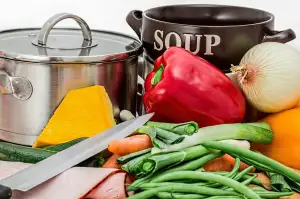Whip Up the Perfect Hummus: A Step-by-Step Guide to Making Mouthwatering Hummus at Home

Hummus, a popular Middle Eastern dip, has gained immense popularity worldwide for its creamy texture and delicious flavor. Originating from the Levantine cuisine, hummus is made from simple ingredients such as chickpeas, tahini, olive oil, lemon juice, garlic, and spices. It is not only a versatile dish but also a nutritious one, packed with protein and fiber. Whether you're a fan of Mediterranean cuisine or simply looking for a healthy snack option, hummus is sure to satisfy your taste buds. In this article, we will guide you through the process of making the perfect hummus at home. Get ready to indulge in this delightful culinary delight!
Ingredients for Hummus
To whip up the perfect hummus, you'll need a handful of simple yet flavorful ingredients. The star of the show is chickpeas, also known as garbanzo beans. These legumes provide a creamy and nutty base for your hummus. You'll also need tahini, a paste made from ground sesame seeds, which adds richness and depth to the flavor.
To give your hummus a tangy kick, you'll need fresh lemon juice. The acidity of the lemon juice balances out the creaminess of the chickpeas and tahini. Garlic cloves are another essential ingredient that adds a pungent and aromatic element to your hummus.
For seasoning, you'll want to have some ground cumin on hand. Cumin adds warmth and earthiness to the overall taste profile. A pinch of salt is necessary to enhance all the flavors in your hummus.
Lastly, don't forget about olive oil! This golden liquid not only adds smoothness but also contributes to the overall richness of your hummus.
With these key ingredients in your pantry, you're ready to embark on a delicious homemade hummus adventure!
Step-by-Step Instructions for Making Hummus
1. Start by rinsing and draining a can of chickpeas. Remove the skins for a smoother texture, if desired.
2. In a food processor, combine the chickpeas, tahini paste, garlic cloves, lemon juice, and olive oil. Process until smooth and creamy.
3. Add salt and cumin to taste. For an extra kick, you can also add a pinch of cayenne pepper or paprika.
4. Gradually add water while processing until you achieve your desired consistency. Keep in mind that the hummus will thicken slightly when refrigerated.
5. Taste and adjust the seasonings as needed. You can add more lemon juice for tanginess or more tahini for a nuttier flavor.
6. Transfer the hummus to a serving bowl and drizzle with olive oil. Garnish with chopped parsley or sprinkle some sumac on top for added flavor and presentation.
7. Serve with warm pita bread, fresh vegetables like carrots and cucumbers, or use it as a spread in sandwiches or wraps.
8. Enjoy your homemade hummus immediately or refrigerate it in an airtight container for up to one week.
Follow these simple steps to create your own delicious hummus at home!
Variations and Customizations for Hummus
While traditional hummus is undeniably delicious, there are endless possibilities for customizing this versatile dip to suit your taste preferences. Here are a few variations to consider:
1. Roasted Red Pepper Hummus: Add roasted red peppers to the basic hummus recipe for a smoky and slightly sweet flavor. This variation adds a vibrant color to your dip and pairs well with pita bread or fresh vegetables.
2. Spicy Jalapeno Hummus: For those who enjoy a little heat, add some finely chopped jalapenos or a dash of hot sauce to your hummus. The spiciness adds an exciting kick that will leave your taste buds tingling.
3. Sun-Dried Tomato Hummus: Incorporate the rich and tangy flavors of sun-dried tomatoes into your hummus by blending them in with the chickpeas. This variation adds depth and complexity to the dip.
4. Garlic and Herb Hummus: Elevate the classic hummus by adding minced garlic, fresh herbs like parsley or cilantro, and a squeeze of lemon juice. This aromatic combination enhances the overall flavor profile of the dip.
5. Avocado Hummus: For a creamy twist, blend ripe avocados with chickpeas to create a smooth and luscious avocado hummus. The addition of avocado adds richness and healthy fats to this already nutritious dip.
Feel free to experiment with different ingredients such as olives, spinach, or even caramelized onions to create unique flavors that cater to your personal preferences. Remember to adjust the quantities accordingly while maintaining the right consistency.
By exploring these variations, you can transform humble hummus into an exciting culinary adventure that will impress your family and friends at any gathering or party. Let your creativity shine through as you experiment with different flavors!
Remember, there are no hard rules when it comes to customizing hummus – it's all about personal taste and experimentation. So, don't be afraid to get creative and have fun with your homemade hummus creations!
Serving and Storing Hummus
Once your homemade hummus is ready, it's time to serve and enjoy this delectable dip. Hummus is incredibly versatile and can be served in various ways. It is commonly enjoyed as a dip with pita bread or fresh vegetables such as carrots, cucumbers, and bell peppers. You can also use it as a spread on sandwiches or wraps for an added burst of flavor.
To enhance the presentation of your hummus, drizzle some olive oil on top and sprinkle with paprika or chopped parsley. This not only adds visual appeal but also enhances the taste.
When it comes to storing hummus, it's important to keep it refrigerated in an airtight container. This will help maintain its freshness and prevent any spoilage. Homemade hummus typically stays fresh for up to one week in the refrigerator.
If you find that your hummus has thickened after refrigeration, simply stir in a little water or lemon juice to achieve the desired consistency before serving.
Remember to bring your hummus to room temperature before serving, as this allows the flavors to fully develop and makes it easier to dip or spread.
By following these simple tips for serving and storing your homemade hummus, you can ensure that each bite remains as delicious as the first. So go ahead, whip up a batch of this delightful dip and savor its creamy goodness whenever you desire!
In conclusion, making homemade hummus is a delightful and rewarding experience. By following the step-by-step instructions and using high-quality ingredients, you can create a mouthwatering hummus that will impress your family and friends.
To ensure you achieve the perfect texture and flavor, here are some final tips:
1. Experiment with different flavors: Don't be afraid to add your own twist to the classic hummus recipe. Try incorporating roasted red peppers, sun-dried tomatoes, or even fresh herbs like basil or cilantro for unique variations.
2. Use good quality tahini: Tahini is a key ingredient in hummus, so it's important to use a high-quality brand. Look for one that is made from 100% sesame seeds without any added oils or preservatives for the best results.
3. Adjust consistency as desired: If you prefer a thicker hummus, reduce the amount of liquid (water or olive oil) in the recipe. For a smoother and creamier texture, add more liquid gradually until you reach your desired consistency.
4. Garnish creatively: When serving hummus, don't forget about presentation! Sprinkle some paprika, drizzle olive oil, or top it with toasted pine nuts for an extra touch of flavor and visual appeal.
5. Store properly: To keep your homemade hummus fresh, store it in an airtight container in the refrigerator for up to one week. Before serving leftovers, give it a stir and adjust the seasoning if needed.
By following these tips and techniques, you'll be able to whip up the perfect hummus every time. Enjoy this versatile dip as a snack with pita bread or vegetables, spread it on sandwiches or wraps, or use it as a flavorful base for other dishes. Happy hummus-making!
Published: 11. 02. 2024
Category: Recipes



